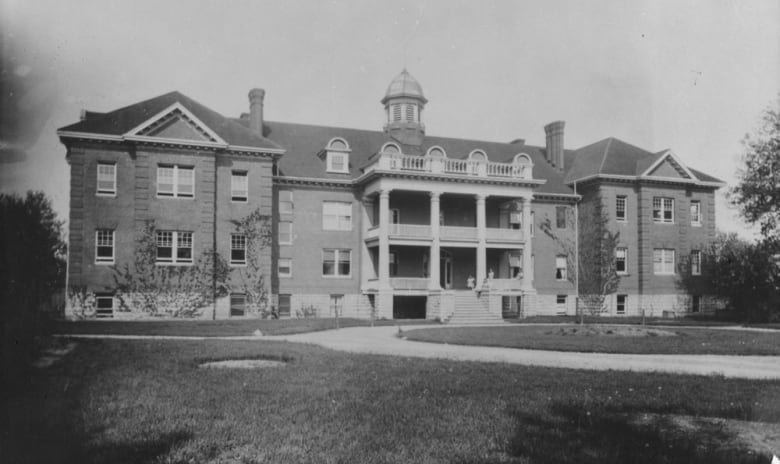
*Warning: graphic descriptions of abuse
Bud Whiteye was literally kidnapped off the road when he was eight years old and forced to attend a residential school.
Thus began his six-year nightmare at the Mohawk Institute Residential School in Brantford, hundreds of kilometres from his home near Chatham, Ont.
He and his brother were walking along the road when two strangers in business attire enticed them into their car with the promise of ice cream.
Hours later, he was at the Mohawk Institute in Brantford. It was in the mid-1950s. He had no idea where he was or what was happening.
His head was shaved as soon as he got there. Almost bald.
“At least leave a little,” he said. Cutting off the long hair of Indigenous children just arriving at residential school was common practice, seen by some as a symbolic cutting off of the child’s connection to their culture.
Upon arrival at the Mohawk Institute, Whiteye got into a fight almost immediately. Not by choice, he said. But that’s the way life was at the school – kids frequently got into fights with the other kids.
There were no toys at the school except a lone swing set that the kids would fight over for a chance to play with.
Oftentimes, the kids fashioned their own toys using scraps they could find from the local dump.
Whiteye was forced to stop speaking his traditional language while he learned things like English, Social Studies and Arithmetic.
In addition to schooling, Whiteye had farm duties. He milked the cows on the farm attached to the school.
Ironically, while he milked fresh milk from the cows, he and the other kids were forced to drink powdered milk. Not once did they get to drink the fresh milk from the cows.
“It tasted like someone put a burnt cigarette into it,” he said of the powdered milk.
Every morning, the kids had to be up at 7 a.m., dressed and ready for breakfast in the basement where they would eat a nauseating meal of sticky porridge and two slices of plain bread every day for the duration of their time at the school.
It was freezing in the basement, Whiteye recalls. The whole school was cold, in fact, he said. The kids would warm themselves up by going into the shower room and running hot water over their hands.
He was always hungry. He and the other kids would forage at the local dump for scraps to supplement the meagre diet they were fed at the Mush Hole – the name given to the Mohawk Institute in reference to the gelatinous porridge they were endlessly forced to eat for breakfast lest they starved.
“I hated the way it felt in my throat,” said Whiteye.
The kids nicknamed the breakfast room where they ate, “The Mush Room.”
He remembers his first beating clearly. It was for one minor infraction that he had no idea was even against the rules. He was playing in front of the barn with a schoolmate.
It was the first of many beatings, he said. He can’t remember who beat him.
The school’s principal, Mr. Zimmerman, is a dark, treacherous figure in the memories of many kids who attended the Mush Hole. The kids nicknamed him “Skin” – a reference to the beatings he used to dole out haphazardly, unexpectedly and brutally.
Years later, when Whiteye was 27, he and his brother tracked down Zimmerman in Brantford with a mind to give him a dose of his own medicine. The boys were strong young men. Zimmerman was a pathetic figure in a wheelchair, wrapped in shawls, hooked up to an oxygen tank. He was now the helpless child and the two men could get their revenge.
“I couldn’t bring myself to do it,” said Whiteye. “I kinda felt pity for him.”
A pity that Zimmerman never showed to any of the helpless children he abused all those years at the Mush Hole.
Whiteye’s experience gets worse. Not only was he hungry, deprived of love, deprived of food, and culturally and physically abused, he was raped repeatedly. He can’t remember who the perpetrator was. It was always in the dark.
“I’d be lying on my back and felt their weight on top of me,” which prevented him from turning around to see who the monster attacking him was. The attacks were so brutal, he bled.
After every attack, he found it hard to look in the eyes of his peers – wondering if they could look into his eyes and know what happened to him the night before, something he was deeply ashamed of.
It took years, until 2003, before Whiteye could finally open up and talk about his experience when he penned, “A Dark Legacy – A Primer on Residential Schools – his heartbreaking and graphic memoir about his time at the Mush Hole.
And although Whiteye struggled with alcoholism as he tried to numb the pain and memories, he became a prominent journalist, working for the London Free Press, the Sarnia Observer, and various CBC affiliates across Canada.
He covered the Oka Crisis in 1990 and became a respected journalist. Whiteye quit drinking for good 10 years ago.
Writing the book was both a painful and cathartic experience for Whiteye, he said. He goes into graphic detail about what he experienced at the Mush Hole but it’s something he believes all Canadians need to hear and understand.
“It took the discovery of 215 children, bodies, for people to understand what we’ve been saying all these years,” he said, noting that every day Canadians seem to finally have “woken up” to the real horrors of residential schools and what they did to Indigenous people across the country.
It’s been almost two weeks since ground-penetrating radar revealed the discovery of a hidden grave holding the remains of 215 children on the grounds of the former Kamloops Indian Residential School in British Columbia. The news sent shockwaves around the world with renewed calls for apologies from the Catholic Church, restitution, and further investigation of residential schools across Canada to find any more similar hidden graves.
Elected Chief Mark Hill has called on the federal government to provide the technology to search the grounds of the Mohawk Institute.
There have long been whispers of graves around the Mohawk Institute.
Whiteye says he doesn’t remember witnessing or hearing of any children actually dying on the school grounds. But he does remember two boys who escaped the Mush Hole and hid out in a nearby corn field for 30 days, subsisting on raw, uncooked corn before they made their way back to the Mohawk Institute.
Whiteye said the boys were brought upstairs to be disciplined and were never seen or heard from again. Nobody knows what happened to them.
He whole heartedly supports the investigation into searching for any more hidden graves in Canada.
The discovery was an awakening for Canadians, and the world, into what really went on at these schools.
Whiteye is now enjoying a quiet and peaceful retirement, living with his son and daughter, and he has put the ghosts of his past to rest.
How long it will take before Canada, and all the churches complicit in the torture of innocent children at Residential Schools, make amends for the past, and present, remains to be seen.








Hello Bud. I’m so sorry to hear of your treatment at the Mohawk institute in Brantford. My mother Marguerite Donovan worked as a secretary to Zimmerman possibly in the late 50 through to the mid 60s. We lived in Eagle place. I can remember picking up my mother as a young boy with my dad as my mother never drove a vehicle. My mother was not a tall person and had redish blonde hair. She was a gentle and quiet lady and never showen any prejudice to anyone that I’m aware of. My mother passed in 1994. I’m just curious if you would have any recollection of her her. Again my sincere apologies for any mistreatment you have received. Also within the last several years I have discovered my grandmother on my dad’s side was Mohawk of Aekwasne. Sincerely Larry Donovan
I had the pleasure of meeting and speaking with Bud Whiteye while doing the TV show "First Contact" season 2. Being raised in the area it was shocking to find out the school was open while I was in school just a half hour away. To learn the horrors of the Residential Schools still has me reeling in disbelief that this happened in Canada. But believe you me ladies and gentlemen, it did.
Of the many things Bud shared with us during our conversation the one thing he said that really drove home the horrors, he and thousands of others endured, was the fact that he did 2 tours of duty in Vietnam, which in itself was a hell on earth. Yet he said if given the choice of where to go if he would choose he would go to Vietnam.